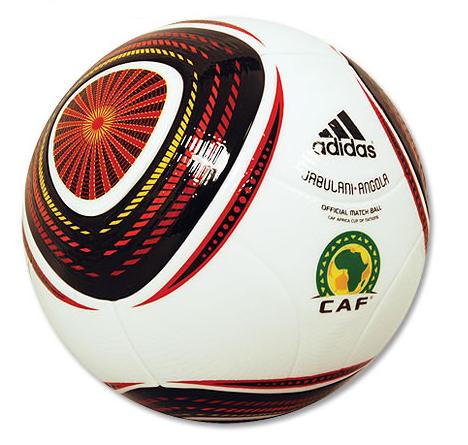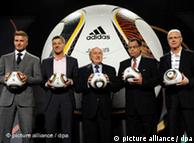
Jabulani - meaning 'to Celebrate' in the isiZulu language - is the name of the new ball for the FIFA World Cup 2010™.
Made, as ever, by Adidas - the world's leading Football equipment manufacturer, the Jabulani ball builds on their years of scientific excellence. With their history of official FIFA World Cup balls (from Telstar to Teamgeist™) the balls have improved year on year, though not without attracting some controversy along the way.
Regular balls are made with 32 hexagonal panels. The Teamgeist for World Cup in Germany 2006 had only 14 panels. The Jabilani ball has an amazing 8 panels.
Goalies will be happy with the 'grip n groove' texturing, which is also to aid smooth flight (think golfballs).
It is a heavy ball, and has bonded 3d panels - moulded spherically to retain shape and create a seamless spehere.
The number 11 carries heavy symbolism - the tribes of South Africa, the players in a football team. In honour ofthis, there are 11 colours used on the ball.
This wonder of technology that took 50 people five years to develop has landed at this monthlong celebration of nationalistic pride with such a thud that some fear it will hurt the level of competition.
The intention was to make a ball that would withstand the rigors of heat and cold, rain and sun. It was supposed to perform equally at high altitude and sea level. It was to be an airtight, waterproof, seamless, ultra-light synthetic marvel of human technology and ingenuity.
But not all see it that way.
"It's very weird," Brazilian striker Luis Fabiano said. "All of a sudden it changes trajectory on you. It's like it doesn't want to be kicked … like someone is guiding it.... It's supernatural."
Teammate Julio Cesar was more succinct.
"It's horrible," the Brazilian goalkeeper said.
Complaining about the World Cup ball is nothing new, of course. Every four years Adidas introduces a new model and every four years just about everyone complains about it.

FIFA Standards / Jabulani Ball Stats
| Feature | FIFA Reg. | Jabulini | Standing |
|---|---|---|---|
| Weight | 420-445 | 440/td> | Heavy |
| Circumference | 68.5-69.5cm | 69.0 +/- 0.2 | Average |
| Roundness | 1.5% Variance | 1.0% | Good |
| Water Absorption | Max 10% | 0% | Amazing |
| Bounce Variance | 10cm | 6cm | Good |
| Leakage | 20% from 3 days | 10% | Excellent |
The weight is interesting - being towards the higher end of the allowed scale means the flight will be truer and more predictable making keepers happy, but also rewarding accuracy for strikers.
This time, however, the criticism seems more universal, centering on the ball's speed and unpredictability — it simply doesn't react like other balls do. And no one seems to know for sure why, though designers at Adidas lay much of the blame on South Africa's thin air.
"It moves around so much … this ball can go anywhere," said Marcus Hahnemann, the backup U.S. goalkeeper. "You can't judge it. And it's taking the skill away from the game.... You can't pinpoint a pass anymore."
The ball was built with improved aerodynamics in mind by using eight thermally bonded three-dimensional panels textured with grooves.
"Players will be confronted with very warm and cold temperatures, wet and dry games, venues at various altitudes," said Hans-Peter Nuernberg, a senior development engineer with Adidas. "Football is an extremely dynamic and fast-moving sport, and it will continue to evolve in such a way.
"Our ball has to reflect these performance aspects and the evolution of the sport. It would not be honest to the players only to change the graphics of a ball."
But what they've done with this ball isn't honest either, say the players.
 "The ball's terrible," U.S. goalkeeper Tim Howard said. "You're going to hear that now, you're going to hear that next week and next month."
"The ball's terrible," U.S. goalkeeper Tim Howard said. "You're going to hear that now, you're going to hear that next week and next month."Added U.S. defender Jay DeMerit: "It's very unpredictable. That's the biggest problem with it. And for goalies and defenders, that makes our day even more difficult."
Not surprisingly, Adidas, the German shoemaker and sports apparel giant that has made every World Cup ball since 1970, defends its work. The company's first official match ball, the Telstar, was also considered revolutionary when it was introduced, yet it remains the world's most popular model 40 years later. Its 32 hand-stitched panels — 12 black pentagons and 20 white hexagons — debuted the same year FIFA put the tournament on live TV in much of the world, and the Telstar, named for a communications satellite, was given much of the credit for making the World Cup a ratings success.
Now comes another ball the company calls revolutionary despite the harsh reviews.
"In general, we can say that aerodynamic studies have shown that any round object shows these movements. Any ball does," said Adidas designer Klaus Rolshoven, who added that the player criticism was "logical because they have to adapt to a different ball."
The tournament opens Friday, so most World Cup players have had only a month to practice regularly with the ball. And the U.S. team's unfamiliarity with it was obvious in last Saturday's "friendly" with Australia, with defenders going up to head balls that suddenly veered off and forwards making passes that never came close to open teammates.
In response to the critics, Adidas, which said it tested the ball in Russian, Dutch, German and Argentine leagues last winter and spring, has launched a damage-control campaign, dispatching many of the players on its payroll — among them Brazil's Kaka, Michael Ballack of Germany and England's Frank Lampard — to counter the criticism, with Ballack calling the ball "fantastic" and Lampard predicting "a lot more spectacular goals … and a lot more spectacular misses."
Kaka went even further, grabbing a ball and giving it a kiss last week at Brazil's Johannesburg hotel.
"I'm not going to criticize the Cup ball," he said. "Everything that's new, new technology, makes a different impression. But who knows if that won't change during the World Cup?"
But whether Kaka's right or whether the critics are doesn't really matter because, as one of his Brazilian teammates said, this is the ball FIFA chose and there's no changing that now.


















No comments:
Post a Comment